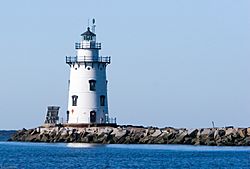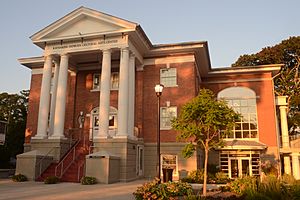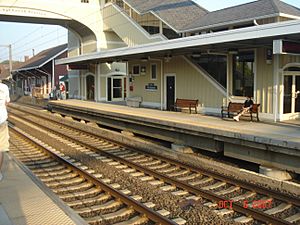Old Saybrook, Connecticut facts for kids
Quick facts for kids
Old Saybrook, Connecticut
|
||
|---|---|---|
| Town of Old Saybrook | ||

Saybrook Breakwater Light
|
||
|
||
 Middlesex County and Connecticut Middlesex County and Connecticut |
||
| Country | ||
| U.S. state | ||
| County | Middlesex | |
| Region | Lower CT River Valley | |
| Settled | 1738 | |
| Incorporated | 1854 | |
| Government | ||
| • Type | Selectman-town meeting | |
| Area | ||
| • Total | 21.6 sq mi (55.9 km2) | |
| • Land | 15.0 sq mi (38.8 km2) | |
| • Water | 6.6 sq mi (17.0 km2) | |
| Elevation | 20 ft (6 m) | |
| Population | ||
| • Total | 10,481 | |
| • Density | 700/sq mi (270.1/km2) | |
| Time zone | UTC−5 (Eastern) | |
| • Summer (DST) | UTC−4 (Eastern) | |
| ZIP code |
06475
|
|
| Area code(s) | 860/959 | |
| FIPS code | 09-57320 | |
| GNIS feature ID | 0213484 | |
Old Saybrook is a town in Middlesex County, Connecticut, United States. It is part of the Lower Connecticut River Valley Planning Region. In 2020, about 10,481 people lived here. Old Saybrook includes the small area of Fenwick and other communities like Old Saybrook Center and Saybrook Manor.
Contents
History of Old Saybrook
Early Settlements and Trading Posts
In 1624, Dutch settlers created a trading post in what is now Old Saybrook. They called it Kievits Hoek, meaning "Plover's Corner." This post was soon left behind as the Dutch focused on their main settlement in New Amsterdam. Later, in 1633, the Dutch built another fort called Fort Goede Hoop in present-day Hartford.
The Pequot War and Saybrook Fort
From September 1636 to March 1637, the Pequot tribe attacked Saybrook Fort. This happened during the Pequot War. The Pequot people attacked settlers who went too far from the fort. They also destroyed supplies and tried to stop river traffic.
Both the Pequot and the colonists learned a lot about fighting during this time. They changed their plans and tactics. These lessons led to more fighting, including the attack on Mistick Fort in May 1637.
Founding of Saybrook Colony
The Saybrook Colony was started in late 1635. It was located at the mouth of the Connecticut River. John Winthrop, the Younger, was named governor of the colony. He was helped by Colonel George Fenwick and Captain Lion Gardiner.
Many of the people who planned to settle the colony stayed in England. This was because of the English Civil War. So, the colony faced difficulties. In 1644, Fenwick agreed to join the Saybrook Colony with the stronger Connecticut Colony. The Connecticut Colony bought the land and fort from him.
Connecticut's Flag and Saybrook Fort
The design of the Flag of Connecticut comes from the seal of Saybrook Colony. Colonel George Fenwick brought this seal from England. It showed 15 grapevines and a hand holding a scroll. The scroll read "Qui Transtulit Sustinet," which means "He who transplanted sustains."
In 1647, Major John Mason took charge of Saybrook Fort. This fort was important for controlling trade on the river. The fort later burned down but was quickly rebuilt. Mason lived there for 12 years. He also served as a leader and peacekeeper. In 1659, many settlers from Saybrook moved away. They bought land from Uncas, the leader of the Mohegan tribe, and founded Norwich, Connecticut. The second fort was used for 200 years. It was removed in 1871 to make way for railroad tracks.
Early Education and Innovation
On October 9, 1701, the Collegiate School of Connecticut was started in Old Saybrook. This school later moved to New Haven in 1716. It was then renamed Yale University.
The first American submarine, called Turtle, was invented in 1775. David Bushnell created it in Westbrook, Connecticut. A copy of the Turtle is now at the Connecticut River Museum in Essex.

Town's Growth and Development
In 1852, Old Saybrook became a separate town from Saybrook. Two years later, in 1854, Old Saybrook was divided again. The northern part became the town of Essex.
In 1964, an important meeting about humanistic psychology took place in Old Saybrook. This meeting helped develop this field of study. Saybrook University in California, started in 1971, is named after this conference.
Modern Cultural Center
In 2007, plans were made to turn the old town hall into a theater. The theater was finished in 2009. It is now called the Katharine Hepburn Cultural Arts Center. The town spent almost $2 million on the renovation. The state also contributed a lot of money. The building was first built in 1901 and was a theater until the 1940s. After being renovated, the theater can seat 250 people. It also displays items related to actress Katharine Hepburn.
Geography of Old Saybrook
Old Saybrook covers about 21.6 square miles (56.0 km2). A large part of this area, about 6.6 square miles (17.0 km2), is covered by water.
Main Communities in Old Saybrook
Old Saybrook has several distinct communities:
- Chalker Beach
- Cornfield Point
- District of Fencove
- Borough of Fenwick
- District of Fenwood
- Indian Town
- Knollwood
- Old Saybrook Center (which includes Saybrook Point)
- District of Otter Cove
- Saybrook Manor
- North Cove
Plants and Climate
Old Saybrook is in a special climate zone. It's a place where some "subtropical" plants can grow well. These include plants like southern magnolias and windmill palms. Old Saybrook has about 90 days a year with freezing temperatures. This is similar to cities like Baltimore, Maryland.
Education in Old Saybrook
Old Saybrook has its own school system.
- Kathleen E. Goodwin School teaches students from pre-kindergarten to grade 4.
- Old Saybrook Middle School is for grades 5 through 8.
- Old Saybrook Senior High School serves students from grades 9 through 12.
The high school's boys' soccer team won state championships in 2018 and 2019.
There are also private schools in town:
- St John's Catholic School for pre-kindergarten through grade 8.
- The Children's Tree Montessori School for toddlers to grade 6.
Some students also attend nearby private high schools like Xavier High School and Mercy High School.
Population and Demographics
| Historical population | |||
|---|---|---|---|
| Census | Pop. | %± | |
| 1860 | 1,105 | — | |
| 1870 | 1,215 | 10.0% | |
| 1880 | 1,302 | 7.2% | |
| 1890 | 1,484 | 14.0% | |
| 1900 | 1,431 | −3.6% | |
| 1910 | 1,516 | 5.9% | |
| 1920 | 1,463 | −3.5% | |
| 1930 | 1,643 | 12.3% | |
| 1940 | 1,985 | 20.8% | |
| 1950 | 2,499 | 25.9% | |
| 1960 | 5,274 | 111.0% | |
| 1970 | 8,468 | 60.6% | |
| 1980 | 9,287 | 9.7% | |
| 1990 | 9,552 | 2.9% | |
| 2000 | 10,367 | 8.5% | |
| 2010 | 10,242 | −1.2% | |
| 2020 | 10,481 | 2.3% | |
| U.S. Decennial Census | |||
In 2010, Old Saybrook had 10,242 people living in 4,247 households. About 23.7% of households had children under 18. Most people, 93.9%, were White. About 2.4% were Asian, and 0.9% were African American. About 3.3% of the population identified as Hispanic or Latino.
The median age in Old Saybrook was 50.1 years. This means half the people were older than 50.1, and half were younger. The average household had 2.21 people. The average family had 2.71 people. The median household income was $80,347. This means half of the households earned more than this, and half earned less. About 5.9% of the population lived below the poverty line.
Transportation in Old Saybrook
Old Saybrook has a train station that opened in 1873. It was rebuilt in 2002. Amtrak, the national passenger rail system, offers daily service. You can travel to Boston, New York, and other cities. The fast Acela Express train passes through but does not stop here.
The Connecticut Department of Transportation also provides commuter train service. This service, called Shore Line East, connects to New Haven, New London, and Stamford. From New Haven, you can connect to the MetroNorth Railroad to reach Grand Central Terminal in Manhattan.
The Estuary Transit District provides local bus services. These "9 Town Transit" services cover Old Saybrook and nearby towns.
Old Saybrook is also served by two major highways. Interstate 95 runs through the town from west to east. It connects Old Saybrook to New Haven and New London. Connecticut Route 9 starts in Old Saybrook at I-95. It goes northwest to Middletown and Hartford.
Media and News
Old Saybrook has one radio station, WLIS AM 1420, which plays a variety of programs. The town also gets news from Shore Publishing and its local newspaper, the Harbor News.
Historic Places in Old Saybrook
Many places in Old Saybrook are listed on the National Register of Historic Places. This means they are important historical sites.
- Black Horse Tavern
- Elisha Bushnell House
- Connecticut Valley Railroad Roundhouse and Turntable Site
- Jedidiah Dudley House
- Samuel Eliot House
- General William Hart House
- James Pharmacy
- Lynde Point Lighthouse
- Old Saybrook South Green
- Parker House
- Humphrey Pratt Tavern
- Saybrook Breakwater Lighthouse
- William Tully House
- Ambrose Whittlesey House
- John Whittlesey Jr. House
Famous People from Old Saybrook
Several notable people have connections to Old Saybrook:
- Vin Baker (born 1971), a professional basketball player.
- Katharine Hepburn (1907–2003), a famous actress who won four Academy Awards. She lived in Fenwick, a part of Old Saybrook.
- John Clellon Holmes (1926–1988), a writer and poet.
- Anna Louise James (1886–1977), the first female African American pharmacist in Connecticut.
- Ann Petry (1908–1997), a novelist and journalist.
- Maria Sanford (1836–1920), an American educator and professor.
Images for kids
-
Gen. William Hart House, 1767
See also
 In Spanish: Old Saybrook para niños
In Spanish: Old Saybrook para niños










